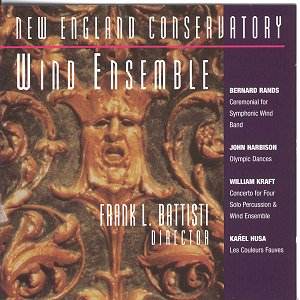Bernard Rands composed three orchestral pieces sharing
the same title Ceremonial (in 1985, 1986 and 1990/1 respectively
and Ceremonial III is available on NEW WORLD 80392-2),
but Ceremonial for symphonic wind band, composed in 1992,
is a quite different piece. After a seemingly assertive chord, the music
becomes fairly indeterminate until the first entry of the bassoon. The
music gathers momentum as the percussion becomes progressively more
insistent leading the work to its emphatic conclusion. Ceremonial
is an impressive processional moving ahead obstinately. The music is
comparatively straightforward (i.e. by Randsí standards), colourful
and superbly scored.
John Harbisonís Olympian Dances is another
fine work for symphonic wind band. The dances of the title however are
indeed more Ďolympianí than overtly dancing in that the music has a
hieratic nobility and restraint, rather that of slow-moving ritual dances
than of bouncing barn dances. The scoring, beautifully effective, sometimes
brings Michael Tippett to mind.
William Kraftís Concerto for Four Solo Percussion
was composed in 1964 and originally scored for full orchestra, and arranged
in 1965 for symphonic wind band. (The orchestral version was recorded
by DECCA many years ago with Zubin Mehta conducting.) The music is lively,
colourful, jazzy at times; and the percussion is used rather sparingly
throughout, thus eschewing the percussive riot one might have expected.
After all, percussion can also play softly. No great masterpiece, maybe,
but a very entertaining piece of music and a welcome addition to the
limited repertoire of percussion concertos.
Karel Husa has composed a great deal for symphonic
wind band for which he obviously have a real liking. Indeed some of
his works exist in orchestral and wind band versions as well. Les
Couleurs Fauves evokes the French painters known as Fauvistes
(e.g. Matisse, Van Dongen, Derain, Vlaminck) whom Husa got to know during
his stay in Paris. The music is appropriately colourful, with many fine
touches of scoring. A brilliant piece and certainly not easy to play,
but the results are well worth the effort.
All these works get wonderful performances and are
warmly recorded. I really enjoyed this release, and the works recorded
here are all worthwhile additions to a repertoire that once was confined
to sometimes dubious transcriptions of famous, though not always great,
showpieces and that has now been considerably enlarged and enriched
by imaginative and sympathetic composers as the ones represented here.
Hubert Culot


